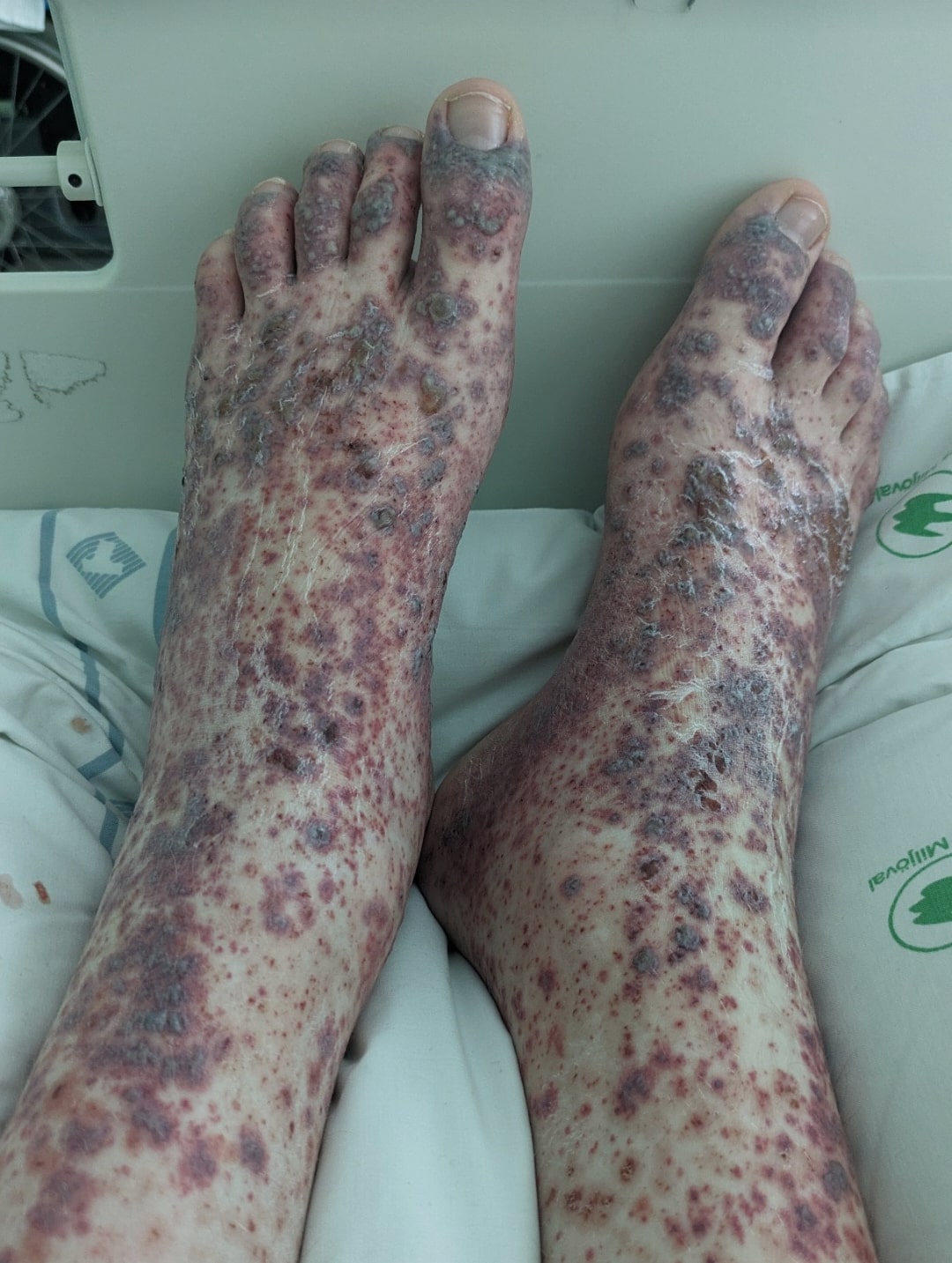What are the symptoms of purpura?
Purpura is a condition characterized by the appearance of purple or red spots on the skin due to bleeding underneath the skin. The symptoms of purpura include:
- Purple or Red Spots: These spots, known as purpura, are typically found on the skin and can range in size from small dots (petechiae) to larger areas. They do not blanch or fade when pressed.
- Ecchymoses: Larger areas of bruising or discoloration, which are often more extensive than purpura, may also be present.
- Bleeding Symptoms: In addition to skin spots, purpura can be associated with other bleeding symptoms such as nosebleeds, gum bleeding, or blood in the urine or stool.
- Fatigue or Weakness: In cases where purpura is caused by an underlying condition such as a bleeding disorder or anemia, the individual may experience general fatigue or weakness.
- Joint Pain or Swelling: In some conditions that cause purpura, like certain types of vasculitis or autoimmune disorders, joint pain or swelling may also occur.
- Systemic Symptoms: Depending on the underlying cause of purpura, there may be additional symptoms such as fever, rash, or organ-specific symptoms related to the primary condition.
Purpura can result from a variety of underlying issues, including blood disorders, vascular conditions, or systemic diseases. If purpura appears suddenly or is accompanied by other symptoms, it is important to seek medical evaluation to determine the cause and appropriate treatment.
What are the causes of purpura?
Purpura can result from a range of causes, primarily related to issues with blood vessels or blood clotting. Here are some common causes:
- Platelet Disorders: Conditions such as immune thrombocytopenic purpura (ITP) and thrombocytopathies can result in low platelet counts or dysfunctional platelets, leading to bleeding under the skin.
- Coagulation Disorders: Hemophilia, von Willebrand disease, and other clotting disorders impair the blood’s ability to clot properly, causing purpura.
- Vascular Disorders: Conditions that affect the blood vessels, such as vasculitis (inflammation of blood vessels) and Henoch-Schönlein purpura (an allergic reaction causing small blood vessels to inflame), can lead to purpura.
- Infections: Certain infections, like meningococcal disease or septicemia, can cause purpura by damaging blood vessels or leading to disseminated intravascular coagulation (DIC).
- Trauma or Injury: Physical trauma or injury can cause localized purpura, often referred to as bruising.
- Medications: Some medications, such as anticoagulants (blood thinners) and certain antibiotics, can increase the risk of purpura by affecting blood clotting.
- Autoimmune Diseases: Autoimmune conditions like systemic lupus erythematosus (SLE) or rheumatoid arthritis can result in purpura due to the immune system attacking blood vessels or affecting platelet function.
- Blood Cancers: Leukemias and other malignancies involving the blood or bone marrow can cause purpura due to abnormal blood cell production or function.
- Nutritional Deficiencies: Deficiencies in vitamins like vitamin C (scurvy) or vitamin K can lead to purpura due to impaired collagen synthesis or clotting factors.
- Connective Tissue Disorders: Conditions such as Ehlers-Danlos syndrome or Marfan syndrome, which affect the connective tissues, can also cause purpura.
- Idiopathic: In some cases, purpura may occur without a clear or identifiable cause.
Determining the underlying cause of purpura is essential for appropriate treatment and management. If purpura is accompanied by other symptoms or appears suddenly, it is important to seek medical evaluation.
What is the treatment for purpura?
The treatment for purpura depends on the underlying cause. Here are general approaches based on different causes:
- Platelet Disorders: If purpura is due to conditions like immune thrombocytopenic purpura (ITP), treatments may include medications to increase platelet counts, such as corticosteroids or immunosuppressants. In severe cases, treatments might involve intravenous immunoglobulin (IVIG) or platelet transfusions.
- Coagulation Disorders: For bleeding disorders like hemophilia or von Willebrand disease, treatment typically includes replacing missing clotting factors through infusions or other therapies to improve blood clotting. Desmopressin (DDAVP) may be used for von Willebrand disease to stimulate the release of clotting factors.
- Vascular Disorders: Treatment for vascular disorders such as vasculitis may involve corticosteroids or immunosuppressive drugs to reduce inflammation and manage symptoms. For conditions like Henoch-Schönlein purpura, supportive care and managing symptoms are often key.
- Infections: If an infection is causing purpura, appropriate antibiotics or antiviral medications will be administered to treat the underlying infection. In severe cases, treatment might also involve supportive care for complications like sepsis.
- Medications: If purpura is a side effect of medication, adjusting the dosage or switching to a different medication may be necessary. Consultation with a healthcare provider is important for making these changes.
- Autoimmune Diseases: For autoimmune-related purpura, treatment often involves managing the underlying autoimmune condition with medications such as corticosteroids or disease-modifying antirheumatic drugs (DMARDs).
- Blood Cancers: Treatment for purpura related to blood cancers may include chemotherapy, targeted therapy, or other treatments aimed at managing the malignancy and improving blood cell production.
- Nutritional Deficiencies: If purpura is due to a vitamin deficiency, supplementation with the deficient vitamin (e.g., vitamin C or vitamin K) can help resolve the purpura.
- Connective Tissue Disorders: Treatment for purpura related to connective tissue disorders focuses on managing the underlying condition and may involve medications, physical therapy, or other supportive measures.
- Idiopathic Cases: For purpura with no identifiable cause, treatment focuses on managing symptoms and monitoring for any potential complications.
The treatment plan should be tailored to the individual based on the specific cause of purpura and their overall health. Regular follow-up with healthcare providers is crucial to monitor progress and adjust treatment as needed.

Leave a Reply
You must be logged in to post a comment.